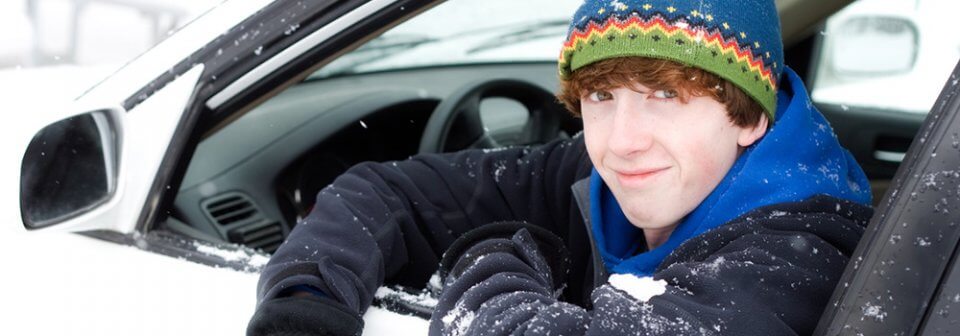
Winter driving is difficult, even for the most seasoned drivers—so imagine how important it is for teen drivers to be prepared for the unique challenges of driving in cold weather. As winter approaches, snow, ice, and freezing temperatures can create hazardous conditions on the road. As parents, it’s crucial to understand the risks and take appropriate precautions to help your teens practice safe driving habits in the winter, and to make sure they have the right auto insurance for their needs.
In this article, we’ll provide valuable tips for teens who will be driving in winter weather, covering everything from preparing their vehicle to dealing with common winter driving challenges. By following these tips, they can stay safe on snowy roads and avoid accidents during the winter season.
Effects of Cold Temperature on Vehicles
Winter weather can pose unique challenges for teen drivers, and it’s crucial for them to understand the risks and take appropriate precautions. One of the first things teens need to be aware of is the effects of cold temperatures on their vehicles. Some of the key effects of cold temperatures include:
- Decreased Battery Performance: Cold temperatures can cause a decrease in battery performance, making it harder for the battery to generate enough power to start the engine. This can leave teens stranded with a dead battery, especially if their battery is old or weak. It’s essential to make sure their vehicle’s battery is in good condition and fully charged, and replaced if needed before the winter season. Consider using a battery warmer or parking in a garage if possible.
- Reduced Tire Pressure: Cold weather can cause a drop in tire pressure, as the air inside the tires contracts in colder temperatures. Underinflated tires can lead to reduced traction and handling, making it more challenging to control the vehicle on snowy or icy roads. Teens should regularly check their tire pressure and inflate them to the recommended levels to ensure proper traction and safety on slippery roads.
- Reduced Traction: Snow and ice on the road can significantly reduce traction, making it harder for tires to grip the road surface. This can result in a longer stopping distance, reduced maneuverability, and increased chances of skidding or sliding. Teens should be aware of the hazards of driving on slippery surfaces and adjust their driving behavior accordingly, such as reducing their speed and avoiding sudden maneuvers. Sudden braking on icy roads can lead to skidding and loss of control, which can result in accidents.
Common Causes of Incidents During Winter
Winter months can pose significant hazards, as snow and ice can create slippery and unpredictable driving conditions. One particular hazard that often catches drivers off guard is black ice.
Black ice is a transparent layer of ice that forms on the road, making it difficult to detect visually. It is called “black ice” because it blends in with the color of the road, appearing almost invisible. It is particularly dangerous because it provides little to no traction, causing vehicles to lose control and resulting in accidents. It tends to form in shaded areas, bridges, and overpasses where the surface temperature can drop quickly.
Other hazards of snow and ice on the road include limited visibility due to snowfall or sleet, especially when combined with common causes of incidents, such as speeding, sudden stops, driving while sending text messages, and loss of control due to slippery road conditions.
Teens should always obey posted speed limits and drive at a safe and appropriate speed for the winter road conditions, avoid slamming on the brakes and instead apply gentle and steady pressure when braking, allowing for longer stopping distances, as well as keep from abrupt lane changes.
Preparing Your Teen’s Vehicle for Winter Driving
Preparing your vehicle for winter driving is essential to ensure your safety on the road. Taking the time to check the condition of your car can go a long way in preventing accidents and ensuring a smooth driving experience during cold weather conditions. Here are some important tips to get your vehicle ready for winter driving.
- Check the tires condition: Make sure your tires have adequate tread depth and are in good condition. Consider switching to winter tires, or snow tires, which are designed to provide better traction on snowy and icy roads. Proper tire pressure is also crucial for optimum performance, so check and adjust your tire pressure regularly during the winter months.
- Inspect your brakes: Have your brakes checked by a professional to ensure they are in good condition and have sufficient brake pad thickness. Properly functioning brakes are essential for effective stopping on slippery roads.
- Check your battery: As we mentioned before, a colder weather can weaken the battery and leave you stranded. Have your battery power tested to ensure it has enough to start your vehicle in cold conditions. If it’s more than a few years old, consider replacing it to avoid any potential issues.
- Check your fluids: Make sure your engine oil, coolant, and windshield washer fluid are at the proper levels and in good condition. Consider using winter-grade engine oil and coolant to ensure optimal performance.
- Install windshield wipers suitable for winter conditions: Clear visibility is crucial for safe driving. Install windshield wipers. Also, make sure to adjust your defrost settings to ensure a clear vision at all times.
5 Recommended Tips for Winter Driving
1. Put Together a Winter Emergency Kit
Putting together a winter emergency kit is a crucial step for teens who will be driving in winter weather. It’s always better to be prepared for unforeseen events, and having essential supplies and tools in your vehicle can make a big difference in case of an emergency. Here are some important items to include in your winter emergency kit.
- Blankets: Keeping warm is essential during winter, especially if you get stranded or stuck. Pack extra blankets in your vehicle to stay warm in case of an emergency. Opt for thick blankets that can provide adequate insulation and retain heat.
- Food and water: Pack non-perishable food items like energy bars, granola bars, and canned goods, as well as bottled water, in your winter emergency kit. These supplies can provide sustenance in case you get stranded for an extended period and need nourishment.
- Tools: Include essential tools in your emergency kit, such as jumper cables, flares, ice scraper, a spare tire, and a snow shovel. Jumper cables can help you jump-start your vehicle if the battery dies, while flares can help you signal for help or warn other drivers of your presence. And a shovel can be used to dig out of snow or create a pathway in snow-covered roads.
- Charged phone: Make sure to have a fully charged cell phone in your kit. In case of an emergency, you can use it to call for help or communicate with loved ones. It’s also a good idea to have a portable charger or a car charger to keep your phone charged during long drives.
- Know whom to call for assistance: Include a list of emergency phone numbers, such as tow truck services, roadside assistance, and local emergency services.
In addition to having a winter emergency kit, it’s also important to have a first-aid kit, and a good car insurance policy to protect yourself and your vehicle in case of any unforeseen incidents. Safe driving habits, such as following traffic laws, maintaining appropriate speeds for road conditions, and avoiding distractions, can also help you prevent accidents during winter weather.
2. Know Your Limits
Sometimes teens think that they are invincible, so it is important that you keep their limits in mind so that they don’t overdo it when it comes to driving in the winter. If teens must go out in bad weather, volunteer to drive so you can keep them safe. If they are going out at night and you are worried there might be drinking involved, be sure they know to call you for a ride. If your teens tend to be the life of the party, ask them to keep friends in the car to a minimum to avoid distractions, especially in rainy or snowy weather.
3. Keep Up-to-Date on Insurance and Maintenance
If your teen’s car is an older model or a hand-me-down, this doesn’t mean that you shouldn’t be vigilant with maintenance and insurance needs. Remind your child to take the car in for routine servicing, or schedule it yourself; things like brakes and tires should be checked before winter hits. And insurance is something that no one should go without—especially teens. Discussing the importance of insurance with your teen is a good start. If you can incorporate your children’s auto insurance into your overall bundled insurance rates, you will feel even more at ease about their safety on the road.
4. Pay Attention to the Weather
While winter driving will always have safety issues (like cold weather and dark evenings), some storms aren’t worth driving in. Keep an eye on the weather and warn your teens about upcoming storms. If you can keep them off the road during peak times for storms or snow, they can avoid a bad situation. If your children must go out in storms, let them know they should stay over at a friend’s home if it gets too late, or volunteer to drive them. Sometimes bad weather just isn’t worth the risk.
5. Practicing Defensive Driving
While your teens may have gone through a driving course and might feel prepared for everything driving will bring, they are still new to the road. If you can instill good driving habits in your teens when winter hits, this can be a good refresher when it comes to taking it easy as a driver. Remind them to slow down in bad weather. This can help them avoid slamming on the breaks and tailgating, both of which can lead to accidents in stormy weather. Your teens should always use headlights in snow, rain, and fog. Good tips start with parents, as the National Highway Traffic Safety Administration (NHTSA) points out.
As a rule, review safety tips for all seasons with your children. It is up to you as a parent to instill good driving methods in your children and let them know the importance of up-to-date auto insurance as well. You can help your teens source car insurance quotes online that will keep them safe and will be affordable for your family. Car insurance rates for teens can be bundled with your family’s other insurance needs to keep costs down. Keeping teen drivers safe should be a priority in any season, but winter weather can pose its own unique dangers that you can prepare your teens for.
Find Affordable Comprehensive Insurance at Freeway Insurance
While you’re checking on anti-theft measures, make sure you’re protected and getting the best rate on your insurance. Get a fast and free car insurance quote online, call us at (800) 777-5620 or stop by one of our convenient locations.



